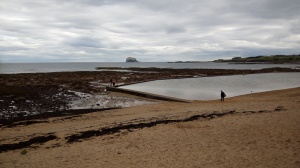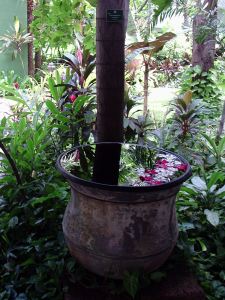I’ve rebooted. I’m renewing myself; my self is new. I’m starting again. At 61, it’s time to embrace my next 50 years of productive, happy, useful and fulfilling life. Everything is up for grabs, anything is possible: work and play, friends and family, where I live, what I do, how I see myself and how others see me. Attending the GTAC conference in November 2016 has been a major part of that reboot.
This is part of my story. If I can get to GTAC and reboot, you can too. Application, Acceptance, Conference, Project.
Summary Haiku
Watch my feet dance now
In my new red pixie boots
Rocking a new tune.
New found freedom scares
And exhilarates me. I
Reach out and kiss life.
Old white woman fears.
But she was wrong two ways: Young,
not old. Not fearful.
GTAC wakes me up.
I hold my head up, standing
proud. I am ready, able.
I hold my hand out.
You take it willingly. Love
and friendship always.
- A formal request to be considered for a position
- Sustained effort
- A program or piece of software
I subscribed to the Google Testing blog, and got an email which said that there would be a conference about test automation (GTAC 2016), and how to apply to go. I thought: “that doesn’t mean me” but I was waking up in my life, and wanted more than I was experiencing. Could I do this? Was I even allowed?
What’s the worst that could happen, when an old white woman applies for a diversity scholarship place at Google’s GTAC conference? That she gets laughed at? Go for it! Being an older woman in tech is not that unusual, but it does feel like being in a minority… And 61 is not old, it is the accumulation of decades in the industry, rich experience, and the knowledge there is more to learn.
So I applied, with the encouragement of friends. I was starting to think about the user experience and usability of testing tools, and how that needed to be addressed. I realised I had a story to tell, about myself, and about the user experience of tools. It took application, but I applied. The act of applying made me look at myself and my life. It made me think more clearly about the UX for test tools. I’d been thinking “Someone needs to do something about this”. Maybe that was – me.
After applying, I had to “forget” GTAC for a while. But I kept working at ideas around the user experience of test tools, attending the CREST workshop, following up on-line with research, writing a paper for UCAAT 2016. I discussed the ideas with other people, friends in the industry. I made an application to the Women in Innovation funding, for money to carry out a project during 2017 to research UX of test tools and develop UX guidelines for tools builders. The application was not successful, but the act of applying made me clarify my ideas some more, and the conversations with colleagues in the industry built my confidence. Something was beginning to happen… and it started with applying to GTAC2016.
- The process or fact of being received as adequate, valid or suitable
- The action of consenting to receive or undertake something offered
- Willingness to tolerate a difficult situation
The day dawned that successful applicants for scholarships would be announced. I had told myself repeatedly not to expect success, so I was disappointed but not distraught when by close of business UK time I had not heard anything. But later that night I could not sleep and was on my laptop, working, surfing, thinking, worrying, self-criticising, when at 4am UK time an email arrived. I had been accepted. I leapt up, amazed, delighted, elated. I was accepted, validated. I accepted the place.
Between acceptance and the conference, in that space of time, my confidence start to grow and yet falter. Could I do this? Was I capable? Would I fit in? All the excitement and frisson of encountering the new was upon me. That delicious yet terrifying mix of anticipations, that urge caution and its opposite, that cause the heart to pound, and the adrenaline to surge.
And yet, amongst the congratulations and the excitement for me, there were those who were dismissive, who said that achieving the place and the scholarship was nothing, and that I would not succeed when I got to the conference. The naysayers and the draggers-down, with their grey and dreary negativity, trying to close around me. I learnt something about the people around me because of applying to and getting a scholarship for GTAC. I learnt who are my friends, who loves me for myself. And so it was that, shortly before GTAC, I walked away from my home and into the light of new possibilities. I started to meet new people, make new friends, present at new conferences.
- A formal meeting of people with a shared interest
I’ve attended and spoken at several conferences this year: story-telling, user experience of test tools and quality in use. Some of these have gone very well, some less so, but each one provides me with lessons, about myself, how people perceive me, what I am capable of, what else I want to do and learn. I’ve learnt from others as well as teaching. At UCAAT in Budapest, I spoke about the user experience of test tools, and about human factors in test automation.
And so to GTAC2016. I arrive nervous, but quickly realise that all the scholarship recipients are in the same hotel and that I’m on the communal list that Joel and others have made – we are in this together! I make a post to my 5 Facebook friends about imposter syndrome, and then over lunch it turns out that the others have had the same thoughts. Am I an imposter? Do I belong? I am amazed – this group of young, vibrant, beautiful, intelligent, witty, accomplished, younger people accept me and they are also a little apprehensive! They are wiser than me in many ways, and I get good advice on networking, social media and smartphone apps…
We visit the LinkedIn offices and Olga is a great host, showing us around, sitting and chatting with us. We start to share experiences. It’s fascinating, hearing the similarities in what we experience. Also, I would like to work somewhere that has a meditation room. And we visit Stanford University. Pink fountains, wildly funny celebrations in music, dance and teddy-bear impalement of the upcoming match with Stanford’s big football rival (CalTech? I cannot remember, all other memories overshadowed by the sight of beefy football players attempting cheer-leading dances.)
In the evening, the reception at the Computing History Museum. Interesting place, but I become overcome with nerves, and my attempts at networking flounder. Thank you, Ari, for your intervention. I survived…
The conference itself, 2 days of great talks, with insights on the need for speed and value in test automation. Over and over, people talk about the need for improved usability and user experience for tools, to enable better productivity for engineers. I listen to people who have research results with evidence that points to how we can improve, to people who have solved practical problems to automate tests in diverse and challenging circumstances, who have succeeded in providing value and speed. I make notes till my hands hurt. My brain fills with ideas and sparkles.
In the evening, there is a funfair. It is worrying. People, noise, strange things to do. I do them anyway… I survive, I enjoy myself.
The highlight talk for me among so many great talks: Niranjan Tulpule gives a keynote where he talks about the democratisation of the development process. I am blown away. He is focused entirely on the need to widen the group of people who can engineers software successfully. He is talking about the drivers that made me think about the user experience of test tools. I start to think more, as he speaks. It is not just engineers who test. It is not just engineers who solve problems. The problems that need to be solved are not just engineering problems. If the tool set allows a wider range of people to engage, we are more likely to reflect the diversity of people in the world, and we’ll get software that solves people’s problems, allows them to work as they want, instead of building software that forces people to be like software.
I finish the conference elated. My brain is happily buzzing, and I want to take the next steps.
And I have learnt in these few days – you can out of your comfort zone and survive. Doing something that makes you look foolish is not as bad as doing nothing. At a conference, we have a lot in common. More than separates us across our diversity. I link to some of the others, and make Facebook friend requests – another small step into the world.
- Enterprise that is carefully planned to achieve a particular aim
- Estimate or forecast
- Extend outwards beyond
- Throw or cause to move forward
So what next? Where will I project myself? How do I move forward? I have two areas of work to explore. Story telling and TX: The tester experience of tools.
Storytelling project: I applied for and have been accepted on a story telling and art workshop in Italy 2017 run by Tania Katan and Angela Ellsworth (The Topography of Memory). This is so exciting! And, succeeding getting a place at GTAC was one factor in building my courage to apply. This blog is a piece of storytelling, as are the haiku that I wrote yesterday on a plane, reflecting on GTAC2016.
TX project: I will do a project on the tester experience of test tools. I made a small survey at a conference in Lisbon last week, to try out a tools usability questionnaire that I wrote. I am going to talk to several people about how to make this project happen. Watch out world: GTAC2016 has given me confidence, motivation and the will to make this happen.
Thank you GTAC2016: organisers, speakers, other attendees, fellow diversity scholarship winners: for being you, for welcoming me, for helping me reboot. With your kindness and friendship, I felt accepted, welcomed, enabled to learn and grow.
GTAC2017, London: looking forward to seeing you all again.

















